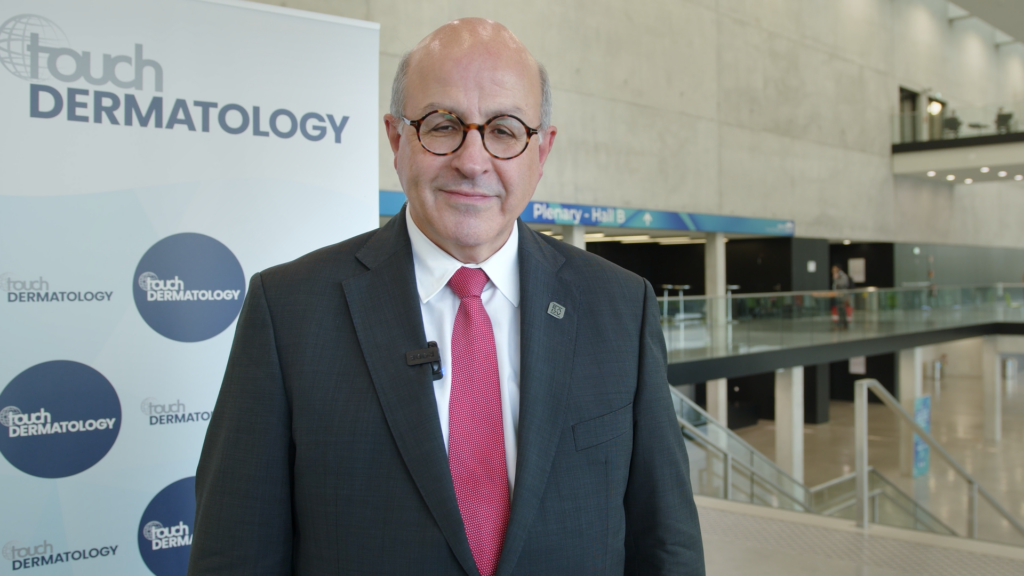TouchDERMATOLOGY coverage from EADV 2024:
Ruxolitinib cream, a topical JAK1/JAK2 inhibitor, offers a potential novel treatment for milder cases of hidradenitis suppurativa (HS). While biologics and systemic treatments are effective for severe HS, there remains a significant unmet need for therapies targeting milder forms. Current topical options, such as antibiotics and corticosteroids, often fail to provide sufficient control, underscoring the need for new therapeutic approaches.
In a double-blind, vehicle-controlled phase 2 study (NCT05635838) in patients with mild-to-moderate HS, twice-daily 1.5% ruxolitinib cream demonstrated significant efficacy compared to the vehicle, and was well tolerated. At EADV 2024, new data on the efficacy and safety of 1.5% ruxolitinib cream were presented from the open-label extension (OLE) period of the study, where patients applied the cream as-needed through week 32.
To explore these results, we spoke with presenter of the data, Prof. Martina Porter (Beth Israel Deaconess Medical Center & Harvard Medical School, Boston, MA, USA) who shared her insights on the findings how they could impact the treatment of both patients with mild disease but also those with potentially more severe disease.
Associated Abstract: Porter M, et al. Ruxolitinib cream for mild-to-moderate hidradenitis suppurativa: 32-week data from a randomized phase 2 study. Abstract N°: 8071. EADV 2024.
Questions:
- What is hidradenitis suppurativa (HS) and what are the key challenges especially in treating milder cases?
- Why was ruxolitinib chosen for this study, and how does it target the disease pathogenesis?
- What were the aims of the phase 2 study, and what data were presented at EADV 2024?
- What did the 32-week results reveal about the longer-term efficacy of 1.5% ruxolitinib cream?
- What was reported in terms of tolerability?
- How might this cream fit into the current treatment options for HS?
Disclosures: Dr. Martina Porter has received consulting fees from Novartis, Janssen, UCB, Pfizer, Trifecta Clinical, Alumis, Incyte, AbbVie, Eli Lilly, Sanofi, Sonoma Biotherapeutics and Prometheus Laboratories. Dr. Martina Porter’s institution has received grants from AnaptysBio, Novartis, UCB, Pfizer, Janssen Pharmaceuticals, AbbVie, Incyte, Eli Lilly, Regeneron, MoonLake Immunotherapeutics AG, Sonoma Biotherapeutics, Sanofi, Bristol Myers Squibb, Oasis Pharmaceuticals, Bayer and Prometheus Laboratories.
This content has been developed independently by Touch Medical Media for touchDERMATOLOGY. It is not affiliated with the European Academy of Dermatology and Venereology (EADV). Unapproved products or unapproved uses of approved products may be discussed by the faculty; these situations may reflect the approval status in one or more jurisdictions. No endorsement of unapproved products or unapproved uses is either made or implied by mention of these products or uses by Touch Medical Media or any sponsor. Views expressed are the speaker’s own and do not necessarily reflect the views of Touch Medical Media.
Transcript:
Hi, I’m Martina Porter. I’m a dermatologist at Beth Israel Deaconess Medical Center in Boston, and I’m also Assistant Professor of Dermatology at Harvard Medical School.
Q: What is hidradenitis suppurativa (HS) and what are the key challenges, especially in treating milder cases?
Hidradenitis suppurativa, or HS, has been around for hundreds of years, with reports even suggesting historical figures like dictators may have suffered from it. In milder cases, HS presents with smaller nodules, but for some patients, it can progress to larger abscesses filled with pus. In severe cases, these lesions may tunnel under the skin, leading to drainage and significant scarring over time. While recent advances have led to more treatment options for moderate-to-severe patients, there is still an unmet need for milder cases. This topical ruxolitinib study is one of the first focused on this patient population. Interestingly, even in milder cases, HS can have a significant impact on a patient’s quality of life.
Q: Why was ruxolitinib chosen for this study, and how does it target the disease pathogenesis?
Ruxolitinib is a selective JAK1/JAK2 inhibitor. Incyte Corporation, which developed the molecule, has used it for other cutaneous inflammatory disorders like vitiligo and atopic dermatitis. Given the success of oral JAK inhibitors for moderate-to-severe HS, it was thought that a topical form could be beneficial for patients with milder disease, especially from a safety standpoint. HS involves inflammation around hair follicles, but its exact pathogenesis is still not well understood. However, the anti-inflammatory effects of ruxolitinib make it a promising treatment option.
Q: What were the aims of the phase 2 study, and what data were presented at EADV 2024?
At the American Academy of Dermatology (AAD) meeting, we presented 16-week data from the double-blind phase of the study, showing that twice-daily topical ruxolitinib cream significantly improved mild-to-moderate HS symptoms. At EADV 2024, we shared results from the 32-week open-label extension (OLE) period, during which patients could apply the cream as-needed. Those originally on ruxolitinib continued, while placebo patients transitioned to the treatment. Results showed a sustained response for the ruxolitinib group, and the placebo group caught up when switched to the active treatment, based on abscess and nodule count improvements.
Q: What did the 32-week results reveal about the longer-term efficacy of 1.5% ruxolitinib cream?
The 32-week results were particularly promising. The fact that the placebo group caught up to the ruxolitinib group implies a real treatment effect. Patients who started on ruxolitinib continued to maintain their response, which is encouraging. The data raises an important question: are we preventing new lesions by treating the inflammation early, or are we simply managing flare-ups better than current treatments like oral antibiotics or steroid injections?
Q: What was reported in terms of tolerability?
The safety data was quite uneventful, which is always a good sign in clinical trials. There were no serious infections reported, and while a few patients discontinued the study, the reasons were likely unrelated to the treatment (e.g., one patient was diagnosed with inflammatory bowel disease and lupus). Common issues like COVID-19 infections, nasopharyngitis, and GERD were also reported, but these are expected in any clinical trial population.
Q: How might this cream fit into the current treatment options for HS?
There are very few options for patients with milder HS, so if this topical treatment can help prevent disease progression, it could be a game-changer. Some patients in this study could have qualified for moderate-to-severe HS trials, given their average abscess and nodule counts. If we can use this topical therapy to control the disease and prevent it from worsening, it would be a valuable alternative to more advanced treatments. In the long term, it could even be used in combination with systemic therapies to achieve better control over persistent nodules.
Interviewer/Editor: Gina Furnival
Cite: Porter M. Encouraging results for topical 1.5% ruxolitinib cream in milder cases of hidradenitis suppurativa. touchDERMATOLOGY. October 16, 2024.



